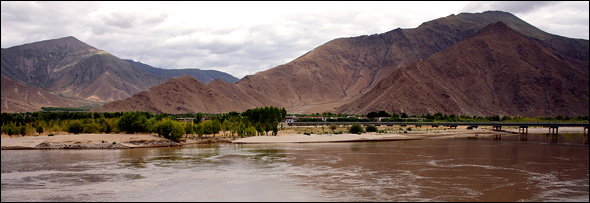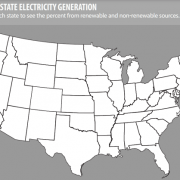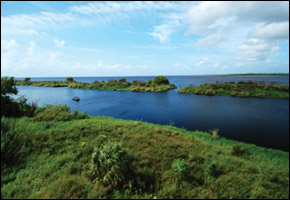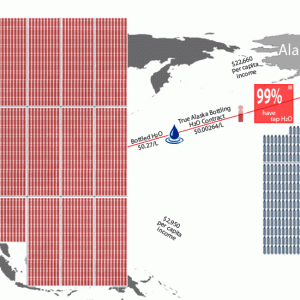China Looks to Increase Hydropower to Meet Clean Energy Goals
While the superpower announces ambitious sustainability goals, it faces droughts and intensive energy needs.
The Yarlung Tsangpo-Brahmaputra River in China is one of the sites proposed for a new hydroelectric dam.
China is looking to bring an additional 120 gigawatts (GW) of its hydropower online by 2015 to aid the growing demand for energy and assist in its endeavors to reduce its carbon dioxide emissions, Reuters reports. The country’s current hydropower use is 197 GW, which is 23 percent of its total national power capacity.
“For new hydropower projects to play a role in China’s move toward energy saving emission reduction in 2020, their construction must be started before 2015,” said the head of the National Energy Administration, Zhang Guobao, Reuters reports.
China has already pursued several well-known hydropower projects including the series of dams on the Lancang Jiang, as well as the well-known Three Gorges Dam. But droughts, combined with the slow growth in hydropower projects due to environmental and managerial apprehension, have limited China’s hydroelectric capacity.
While China’s southwest region is a major source of hydro-electricty, persistent drought has decreased water levels in the reservoirs, resulting in a nationwide decline in energy output, according to the Guardian.
Meanwhile figures published by China’s National Bureau of Statistics show that the energy output from hydropower in 2010 was down 1.4 percent in January, 13.6 percent in February and 1.5 percent in March compared to the same months in 2009. And although the drought has since eased, severe dry conditions persist in Yunnan Province, which is home to several proposed dams.
In April, the drought experienced in the Lower Mekong River Basin, which is shared by Laos, Thailand, Cambodia and Vietnam, prompted calls for increased regional cooperation regarding China’s plans to build several more dams on the upper reaches of the Mekong River.
But the country sees hydropower as a major part of its ambitious plan to increase use of non-fossil fuel by 15 percent, and improve the energy efficiency of its economy by 40 to 45 percent in a decade.
Despite these ambitions, Jennifer Turner, director of the China Environment Forum at the Woodrow Wilson International Center for Scholars, told Circle of Blue that there is no silver bullet to the superpower’s energy consumption and emissions.
“China’s energy needs are mind boggling,” Turner said.
Even with the advancements in green technology and increase in hydropower usage, coal will still make up about 50 percent of its energy portfolio, according to Turner.
While the country achieved a 14.4 percent reduction in energy intensity by the end of 2009, levels increased by 3.2 percent in the first quarter of 2010. It also witnessed a 24 percent increase in sales of coal-fired electricity and oil compared to the first quarter of 2009, due in part to a 22 percent increase in China’s fuel-intensive industry output, the New York Times reported. In addition to the increase in consumption of fossil fuel, the non-fossil fuel ratio decreased by about one percent in 2009.
Increasing the generation of hydro-electricty would increase the available energy-output by non-fossil fuel sources and the country’s efforts to meet its clean energy targets. One of the most recently proposed projects is a 38 GW mega-dam at the Great Bend of the Yarlung Tsangpo-Brahmaputra River, the Guardian reports.
Tashi Tsering, a Tibetan scholar of environmental policy at the University of British Columbia, told the Guardian that the there are 28 projects on the table for river, which flows through the South Tibet Valley.
“This dam could save 200m tones of carbon each year. We should not waste the opportunity of the biggest carbon emission reduction project. For the sake of the entire world, all the water resources that can be developed should be developed,” Zhang Boting, deputy general secretary of the China Society for Hydropower Engineering, told the Guardian.
However, Turner notes that the regulatory and political impacts of damming the Brahmaputra, an already water stressed region, must be taken into account. It is important to look at the big picture when considering China’s energy portfolio and keep in mind China’s limited resources, she said.
“Will it be money well spent to build dams for short term benefits with uncertainty in the long term?”
Sources: New York Times, Reuters, UPI and the Guardian










dams are like a two edged sword…some would say in the US that something like Hoover Dam would never get built today because of the environmental regulations. I’d argue it wouldn’t get built today because it would not pencil out on the economic front.
Aswan Dam is another classic example. Yes, it has allowed increased agricultural production through irrigation but it has decimated the Nile delta fisheries, removed the natural flushing of salts and nutrient recharge, and increased health problems (bilharzia anyone?). Aside from salts building up in the soils, there is also seawater intrusion into the delta impacting water supplies for millions AND there is no longer replenishment of sediments along the delta. So the delta is retreating and/or sinking.